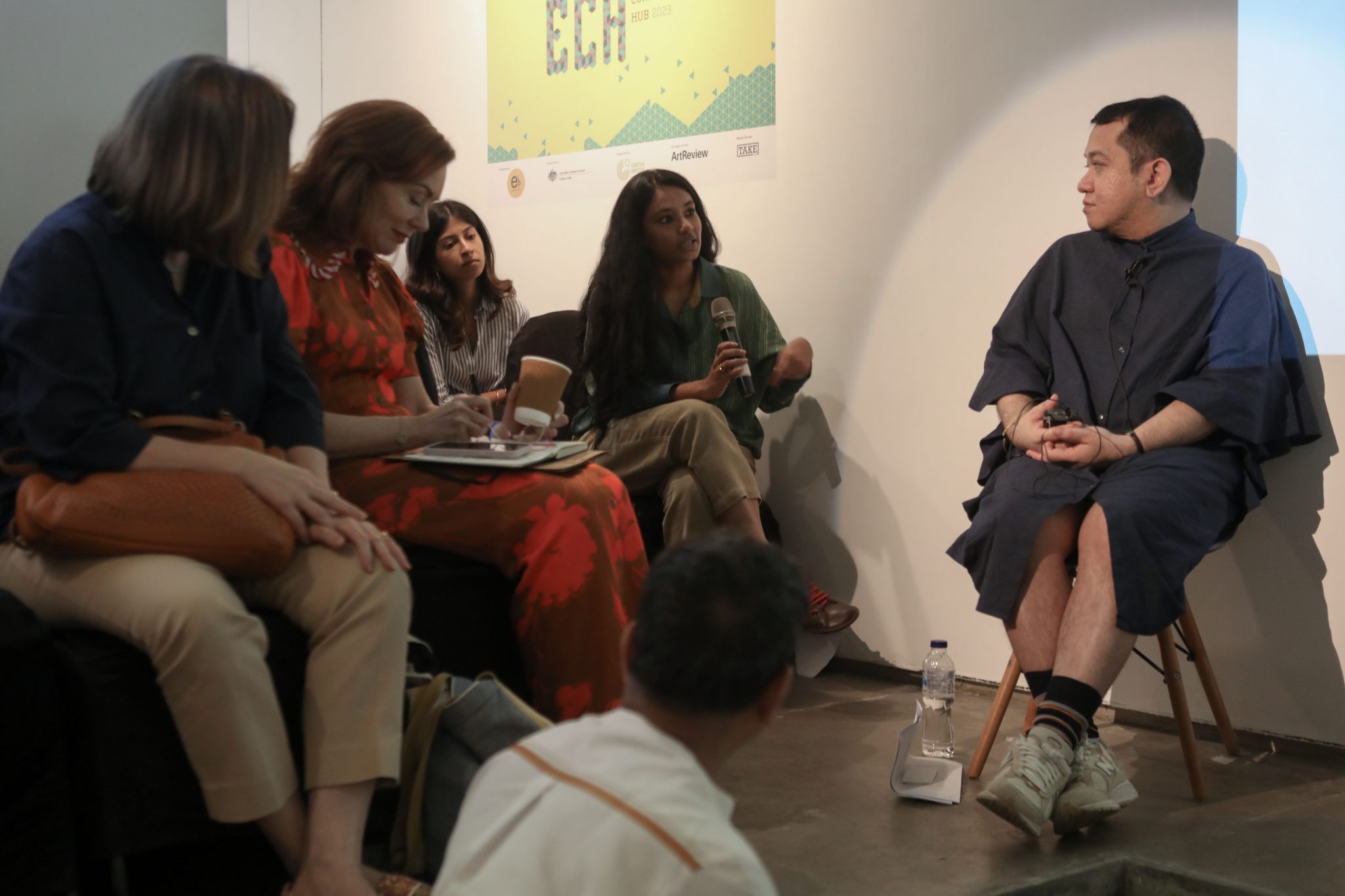Inside the 13th edition of Experimenter, a platform for developing and sustaining discourse on curatorial practice and exhibition-making through critical discussion and debate
Last weekend, Experimenter Curators’ Hub returned for its 13th edition at Experimenter – Hindustan Road, in partnership with ArtReview. Experimenter Curators’ Hub is a platform for developing and sustaining discourse on curatorial practice and exhibition-making through critical discussion and debate. Structured as a deeply intensive program, each year the hub invites some of the foremost curators of the world to present their practice with reference to recent exhibitions curated by them. The audience at Experimenter Curators’ Hub play an active role in this exchange and contributes significantly to the conversations. The final day ends with a moderated panel discussion with all the participating curators and collaborators reflecting on the key aspects that emerged over the course of the hub.
This year, writer and critic Mario D’Souza kept a diary.
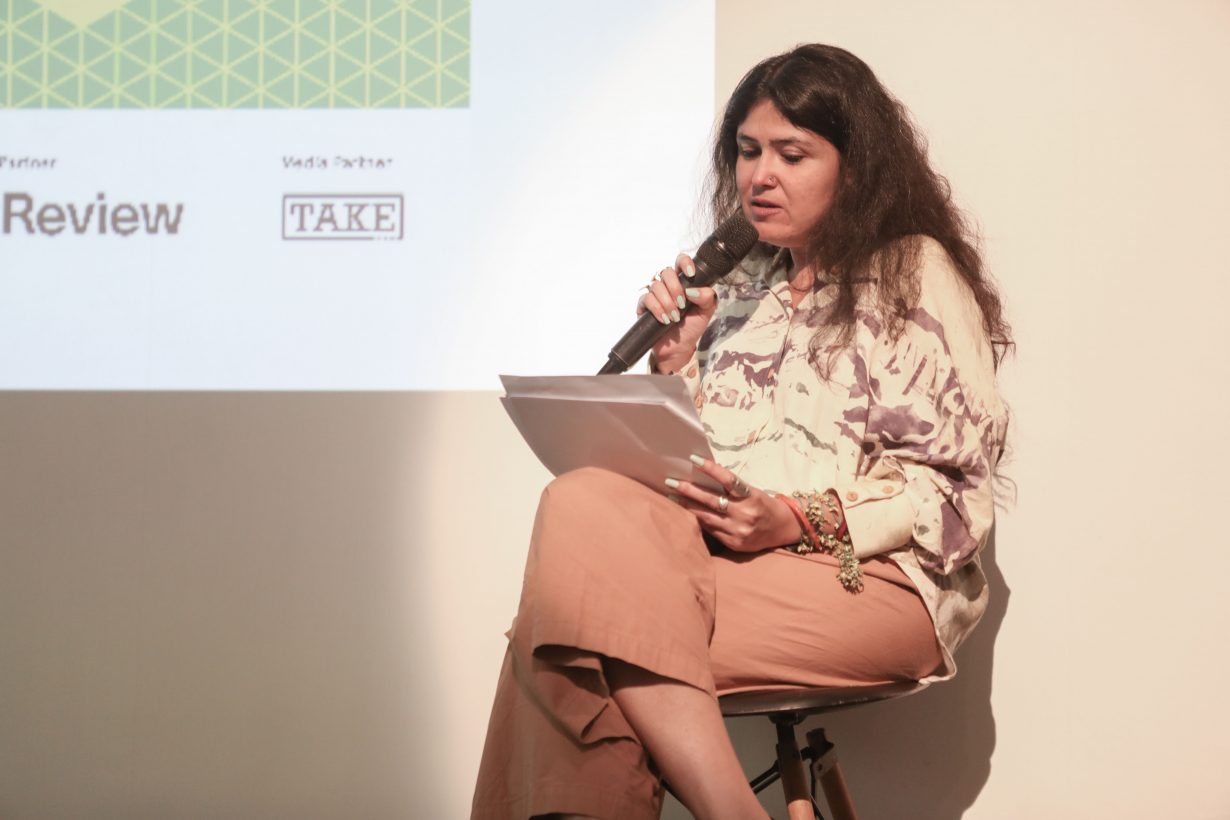
Day 1
Natasha Ginwala in her opening framework noted: “In a moment of amplified polarization, racist ousting, gas lighting of those who rise in dissent, and the threat of deportations and mass displacements as imperial war machines and corporate power go on destructive rampages; as malice is planted where tenderness once grew – it is impossible to address any creative quest without awareness to this passage and its debilitation.” This edition of the hub was conceived in a very different world and we gather in a very different, fractured, complicit world – a sensation present in the opening remarks of Prateek and Priyanka Raja, co-founders of Experimenter.
Ginwala offers a reminder of what this hub is not meant to be – “not to be prescriptive, deliver consensus, nor sterile solutions to feed the art market” instead it is to revel in learning by doing, in knowing art is a risky business in the best sense, and thus take seriously what it means to release an open body of knowledge into a troubled world.” Ginwala opens with the potential of poetry and stories as a form of re-worlding or producing new worlds – a gesture the speakers through the day will contribute to and depart from.
Ginwala returned to Ann Boyer to cite from her resignation from the New York Times as an aesthetic provocation: “If this resignation leaves a hole in the news the size of poetry, then that is the true shape of the present”.
How can a network of care be understood at the heart of curatorial relations: to artists, each other, community, artworks and audiences, writing and listening? asked Natalie King during her presentation. King curated the New Zealand pavilion at Venice with artist Yuki Kihara that reconfigured the while man’s gaze (after Kihara encountered Gaugain’s paintings in New York) with trans bodies while also reminding us of the precarity of queer ecosystems to climate change. King notes Kiharu’s work as an exploration of intersectionality, decolonisation and environmental crisis from a distinctly Pasifika perspective. Care extended in the logistical and practical as well for King, with the formation of the firsts solidarity network, a peer to peer support and shared events by the pavilions of Albania, Singapore, Nepal, Poland and the United Kingdom. The delayed biennale with a plethora of on ground challenges were navigated collectively and audiences were shared across events and conversations during the Biennale Arte 2022.
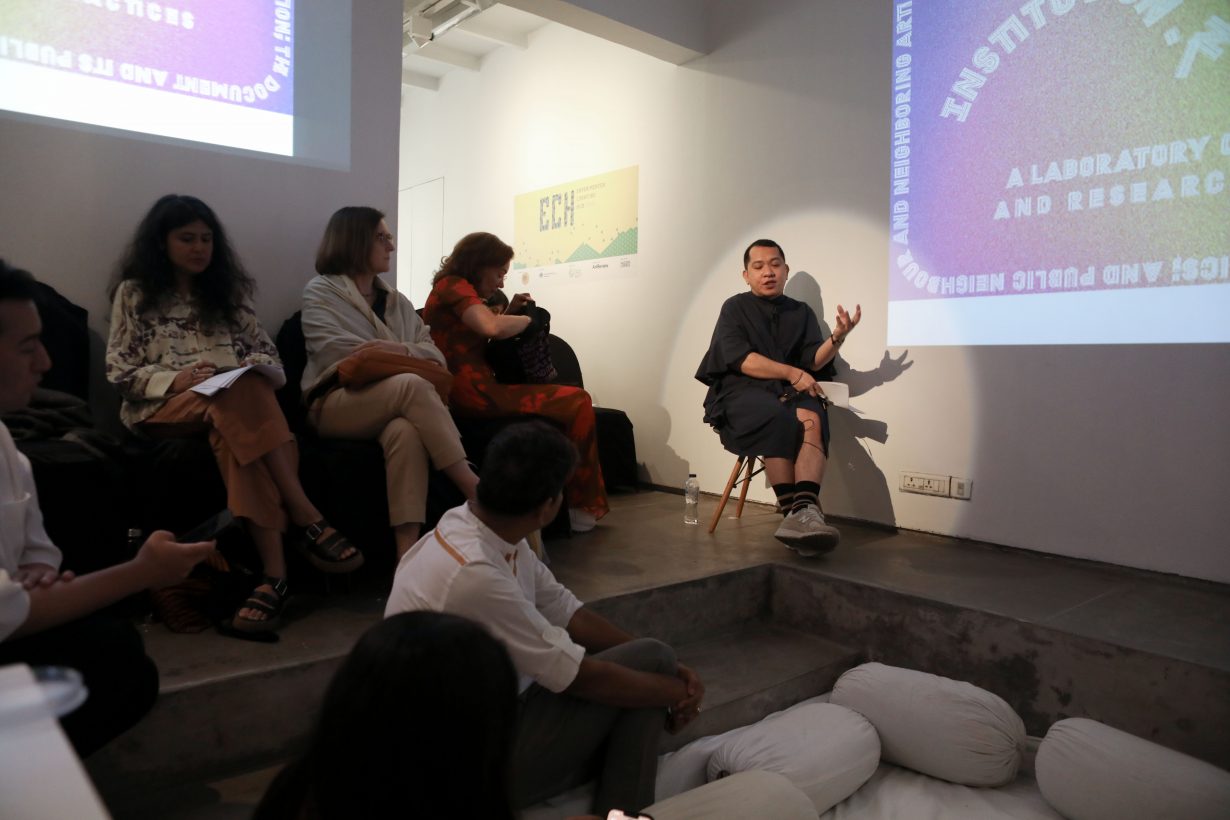
This tending is not far from Renan Laru-an offering of the Loob, which loosely and not satisfactorily translates to the inside, interior states and inner beings – the heart and will. “In a western construction of subjectivity, loob invites non-translation and permanent translation offering qualities that abstract, cultivate, extract, and graft existing and new values and worlds.
Laru-an also offered the framework of Institution-in-Rehearsal, that enacts its processes and methods as ways of (re)articulating Savvy’s vision as a “laboratory of form-ideas”. I quote: “this takes the form of tutoring as an active method of sharing the organization’s histories, methodology, and operations, in which SAVVY members externalize, disseminate and deliberate these concerns together with a group of students, who are peers and publics of SAVVY’s work” which contributes to Ginwala and Laru-an’s discussion about the neighborhood and how to not be a satellite without a landing but an active community member that contributes to a nourishing coexistence.
A photograph of a dense grove of trees, where roots had found soil and become beings over time was placed in one of the final slides of Sohrab Hura. This encounter in Andhra Pradesh provided a curatorial framework where one doesn’t hold ground but makes space for other people and ideas to root in. Sohrab, along with his peers have actively, collectively worked to build a network of conversations and knowledge sharing with generations of image makers in the region. Where “political, geographical and cultural” borders are tough – visions and ideas as images have travelled. Growing like a tree – twists and turns, enmeshes – bringing in a diversity of voices, which in turn continue to tender their own trees.
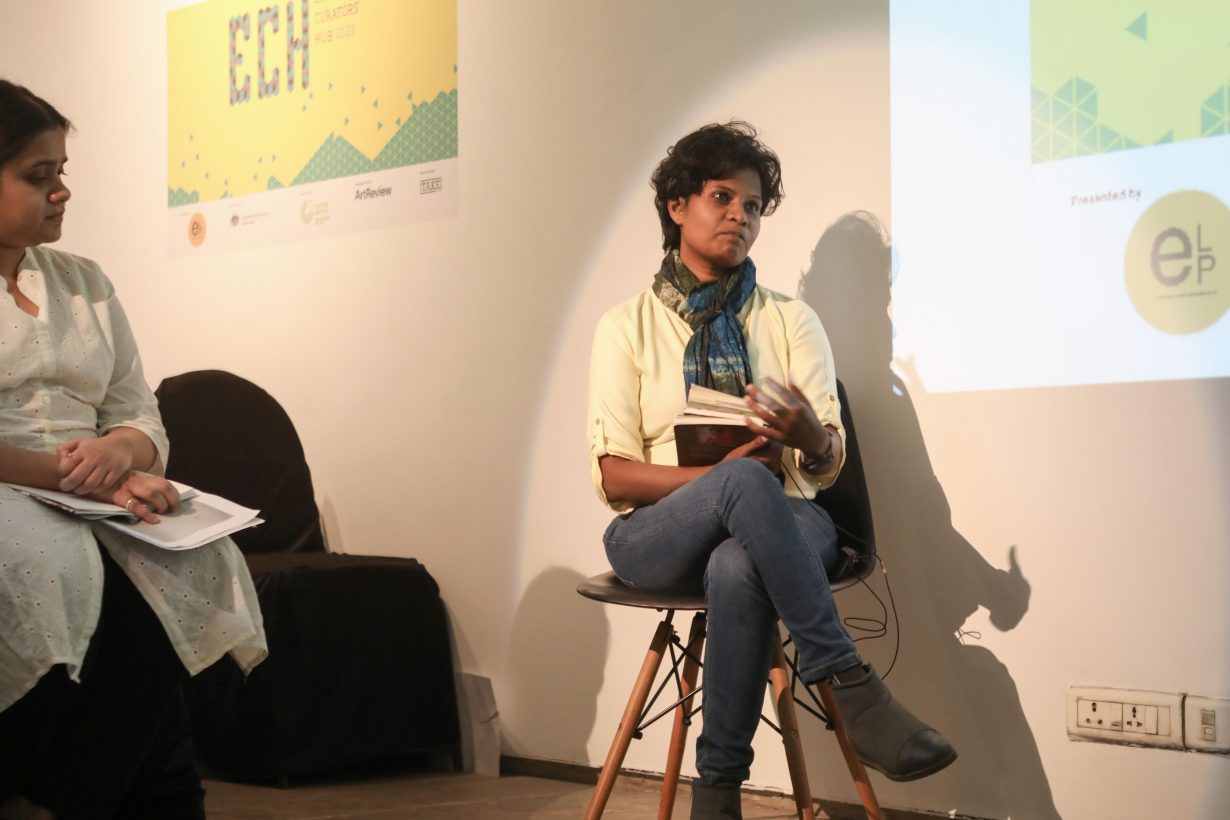
We return to trees again in the poems of Jacinta Kerketta, possibly the most important voice at the hub this year. Kerketta is a journalist, poet and activist belonging to the Oraon tribe, in the West Singhbhum District of Jharkhand. In Kyon Mahue Nahi Tode Jaate Ped Se (Why do we not break mahua from trees), she read (and I use a translation here):
Mother, why do you wait all night
for the mahua to drop?
Why don’t you not
just pluck all the mahua from the tree?
Mother says –
They live in the womb all night long.
When the time for their birth comes
They fall by themselves to the earth.
At dawn, when they’re soaked in the dew
We pick them up and bring them home.
When the tree is going through
Labor pains all night long
Tell me, how I can
shake the branch hard?
Say, how I can forcibly
pluck the mahua from a tree?
We just wait
Because we love them.
Kerketta offered us learning from her own life, aspirations and frustrations. In the biographical, she offered her lived experiences as the only history, with accountability and care. She dismantled the expectation to speak for the community and instead chose to speak ‘from the community’, as one of the voices, one of the histories. This is so close to the artist and educator Brenda Fajardo that Renan Laru-an introduced us to in his presentation. Brenda opened her speech at the National Art Center stating that the artist’s position is “a biographical thing.”
She read (and once more I use a translation here):
Those who sell their honesty,
For bits of money,
Can hardly understand,
Why some people give their lives,
For the mountains.
Upon being asked why she writes in Hindi as opposed to her native Kurukh, she explained with sharp honesty how she doesn’t believe in preferencing a language. Hindi becomes a language that connects Adivasi communities across the eastern and northern region that speak a diversity of native languages. A common denominator, a meeting ground and accessibility is what she is interested in and not the politics of language.
I end, with how she did and offer her offering:
Intezaar/ Waiting
They are waiting for us to become civilized
And we are waiting for them to become human.
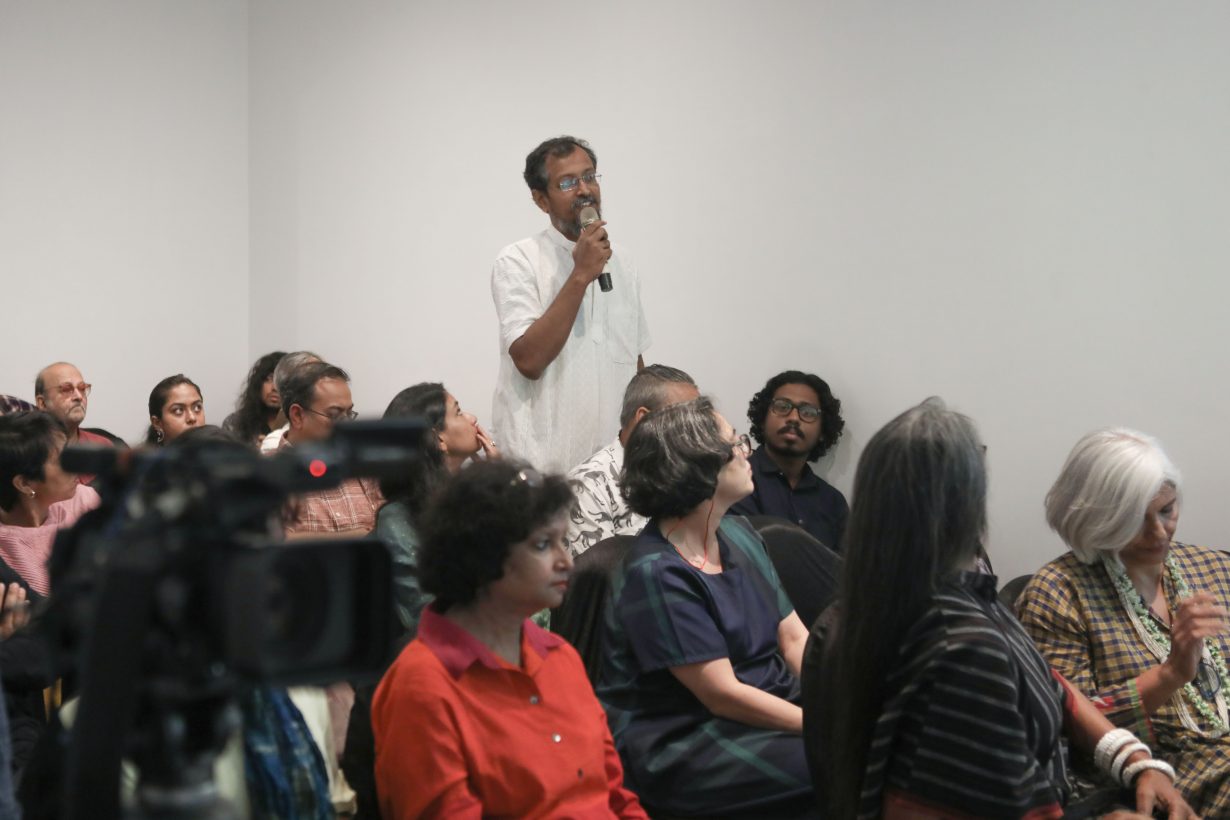
Day 2
The day started with an invocation of the verses of Ada Limon, and an acknowledgement of the tenacity of Jacinta Kerketta poetry from the previous day.
Natasha Ginwala reads:
to be more human
to be in close connection with the earth
to be in revolt against all fetters
beyond ‘falsely holding onto symbols and emblems.’
With the pressure towards individuation and cultures of atomization – existence in silos even at the cost of ‘the many’ how may curatorial labour attend to the collective?
Inti Guerrero, co-artistic director of the Sydney Biennale, presented the third edition of the project Specter Synthesis cocurated with Chantal Wang. The mandate was to present LGBTQ+ perspectives from “artists in Asia and the many Asias that exist both in the continent but also the diaspora”. Curators, he notes, have a way of negotiating things. An example he states is how gay marriages have become a subject amongst the progressive intellectual west, “but you want to be critical as the discussions can also be instrumentalized by political structures”. Recent images of IDF soldiers holding the rainbow atop ruins in Gaza is evidence of this pink-washing context of Israel.
Guerrero also introduced us to the modalities under which queer art in the region was made and how the mediums of choice were ones at hand. The works of Alphonso Ossorio for example, a privileged, out, New York based queer icon from the 1950s. Ossorio had to return home to the Philipinnes under pressure from his family to paint a mural in the brutalist Chapel the family were building in the sugarcane plantations on Negros Occidental. The return was brutal for Ossorio and his identity. The repression led to a mural painted in rage. We were also introduced to the archive of Anita and Ava, who since their teenage years registered their transformation through photographs. The proliferation of photo studios across Penang enabled and encouraged self-portraiture as a medium.
Sharareh Bajracharya presented her work with art and education in Nepal through the Srijanalaya initiative that engages with children and people alike through activities. Bajracharya calls her work education “to give people in Nepal a language for the work we are doing because they don’t understand as much”. But it is essentially practices of art and storytelling that have to be reframed to be made accessible. Ginwala speculates “publicness” in the contribution of various artists to these activities – and activities as a way to share and understand our political and social lineages and histories.
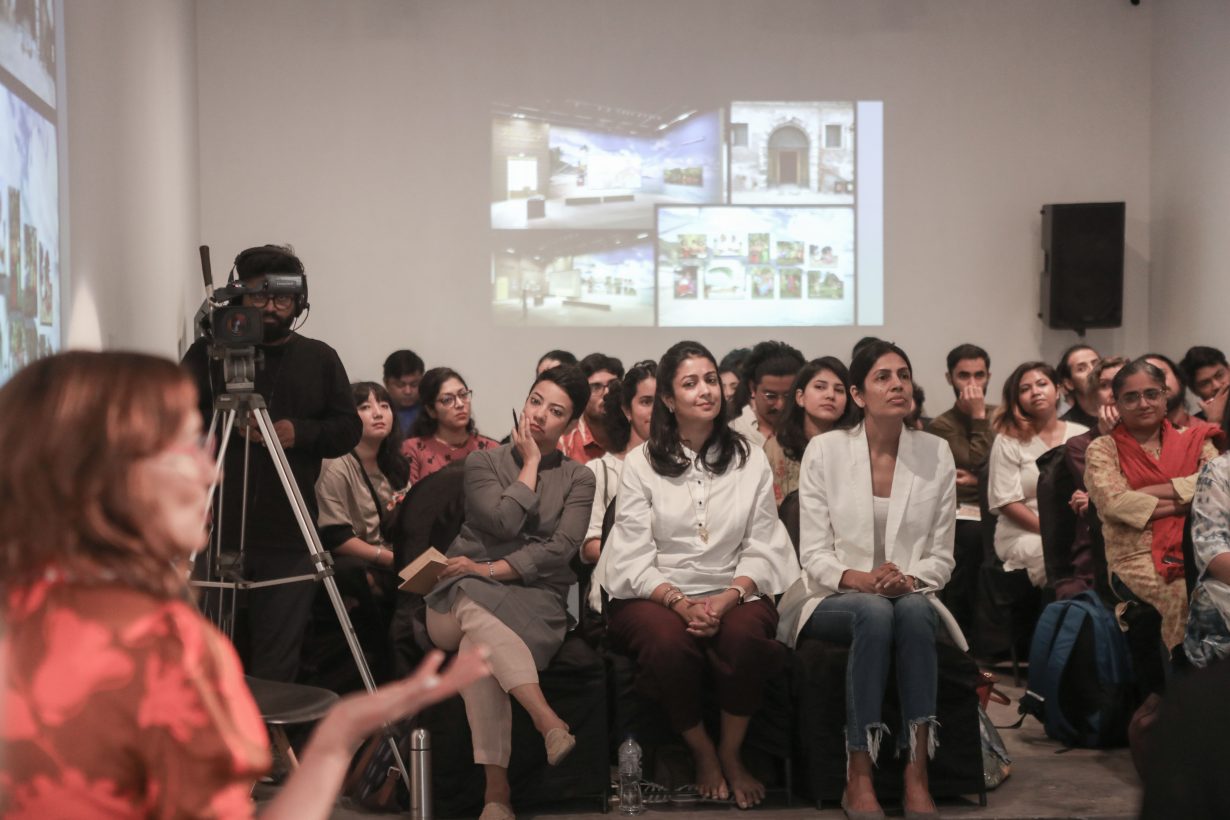
Shubigi Rao, curator of the 5th edition of the Kochi-Muziris biennale suggested the margins were not only a space of survival but also a space of thriving. Those in the margins must constantly come up with innovative, agile strategies of preservation. This is why her title for the biennale, taken from her own drawing was a homage to the survivors of the genocide in the Balkans. In the title In our veins flow ink and fire, she is interested not in fire or ink but in the act of veining – “what happens when things flow? How do stories but also dangerous ideas travel?”
Responding to Rao’s presentation, Ginwala invoked the old saying, “the paper burns but the words fly away”. She asked about the reinvention of language – ignoring as a strategy or to speak in tongues – or to be placed between languages to be opaque to readings or understanding as a strategy. Rao continued to remind us how it was so important to protest, to occupy streets but also to infiltrate in covert ways. “Violence is the right of oppressed people and language is the tool of the oppressor” she noted.

The relationship between architecture and textiles was one of the thrusts of Mayank Mansingh Kaul’s presentation, besides of course how the present and its imagination affects materiality and language. In his presentation was a sari from Varanasi, dated between 1939 and 1945. Kaul noted the “patterns conventional to its current repertoire” illustrating how the artisans were absorbing images from newspapers or producing them through imagination after listening to the stories of war on the radio. Do we see it as historical, contemporary or modern textiles then? Kaul also foregrounded the gap of textile histories in architecture – illustrated with an image of Fatehpur Sikri – stating that architecture was merely the shell, a frame that can host textiles like we see in the Mughal miniature paintings.
During the concluding, collective conversation the curators prompted by Ginwala mulled over the longer-term impacts of the pandemic, particularly artist-run and independent spaces that had to disband. What are the strategies of survival or mutation? Natalie King suggested the format of reading groups that enable us to share and learn, and produce a collective understanding of the world in dialogue with one another. Sohrab Hura continued to point out the flaw in the standardization of curriculums stating that “one size fits all” is a problem. “We are looking at everything from one prism”. The pandemic allowed us to break out of the pressures of institutional umbrellas and shift to “something lighter and more agile”. Sharareh Bajracharya spoke from the Nepal context where “things don’t just happen”, the politics offered the Triennale a sense of slowness and time to do things and organize better.
Ginwala asked Jacinta Kerketta about the networks she’s developed, while identifying them as systems that enable both echolocation, preservation and nourishment. Kerketta stated how when she writes in the city its city-ness takes over. When she was traveling through rural Odisha, and lived the lives provided by her hosts – she understood a situatedness. She noted how the country looked so different from the rural as opposed to how the country looks from the urban. In the rural, there is a sense of fearlessness, a clarity.
